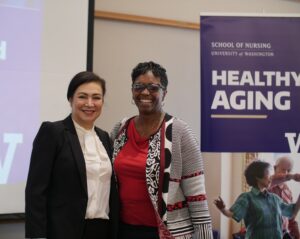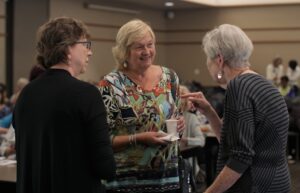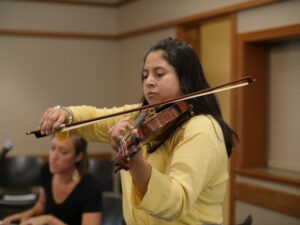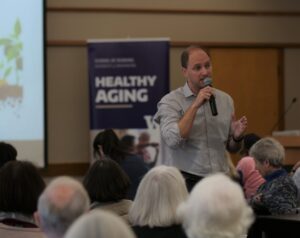Najma Mohamed is a first year BSN student. During winter quarter in 2020, she traveled to Japan as part of the Keio University Short-Term Nursing and Medical Care Studies Program to learn about challenges of an aging society. UW students attending the program were supported by the Center for Global Health Nursing and the de Tornyay Center for Healthy Aging.
All interviews have been edited for length and clarity.
Find all scholar spotlight interviews here.
What interested you about the Keio University program?
I was interested in pediatrics, but the program centered on aging populations and elderly care. That was very different from what I was hoping to get into in the future. I thought if I had more experience and more knowledge about that particular area it could also be something I want to explore.
What interested you about healthy aging?
My family’s originally from Somalia so for us, when it comes to aging, it’s the women who take care of the aging and their elderly parents. When you have an aging population there is a burden on the caregivers. In Japan a lot of what I learned was different ways that they mitigate that. I thought I could come back and apply it to my own community and figure out how we can take care of our elderly people without placing undue burden on the woman who are caring for them.
How do they mitigate that burden on caregivers in Japan?
If you’re over 75, you’re entitled to two visits a week from a nurse in your own home to care for you. People tend to be healthier and get better when it’s their own personal space and they have control over it. We also did a visit to this community where you have the elderly living there and the nurses taking care of them living there as well. It removes stigma and creates a healthy and open environment.
What was the most interesting experience of your trip?
We rode bikes to go visit the homes of the people we were doing nurse visits with, and I haven’t ridden a bike in forever. Over there, they don’t have bike lanes and I spent much of the trip swerving through people and cars. Bikes over there are used as a huge means of transport for nurses, but here, going to clinicals I either drive or take a bus. It was an eye-opening experience to see how different the transportation that they rely on is.
What were the nurse visits like?
We did two. In one of them, the family was very much involved. Seeing how the nurse separately communicates with the family and the patient, and then brings them back together, I thought was really interesting.
The nurse put so much care and effort in. We watched the nurse make food for their patient, feed them, and give them their medication, they had to get that all done within two hours. They did extra stuff to make the patients smile, they really knew their patients very well. Having eight patients as a nurse is tough, but they handled it really well.
Was there anything that surprised you while you were there?
Their shifts were really different, we have the night shift and day shift here, but they have 8 hour shifts. In Japan, you don’t really get to pick your own schedule, you just tell them when you’re available and they schedule you for one of their three shifts. In Japan and Korea, nurses don’t have as much power. I was telling them that we just had a strike with nurses feeling unsupported and how when something’s not going well you can voice your opinion and make a change. But over there it’s a lot more difficult. There’s more hierarchies for nurses.
What did you learn about aging while you were there?
One thing that was reemphasized for me is aging with dignity. That was one of the biggest aspects of our program, understanding that people are more than their symptoms. People want to live and die with dignity. So to hear it being emphasized everywhere we went, I thought that showed the commitment and dedication the Japanese have to healthy aging.
Why did you choose nursing?
No one in my family is in healthcare. I wanted a major where I could make a difference in my community and still be able to support my family. People come to us on their worst days and being able to make a difference no matter how small means the world to me. The other thing that drew me to nursing was how flexible it was. There are so many roles a nurse can take on and every day brings something new.
What’s been an unforgettable experience during your time at the school of nursing?
This quarter, I am doing a clinical in community health and it’s been amazing. I spend majority of my time working with elementary school students and every day I learn something new from them. I always leave at the end of the day smiling, reminded of why I wanted to pursue nursing. The nurse there serves as a cornerstone for the entire school and witnessing that has taught me a lot about the role of a nurse in community health.
How has your experience at nursing helped you with your career trajectory?
After being at the school of nursing, I know for a fact that I want to go back to school after graduating. I hope to get my DNP at UW and expand my scope into working with communities. I can say without a doubt that all of the faculty, staff and peers at the school of nursing have helped me grow. Just being able to say I’m a Husky Nurse, I love it.
What are your plans after graduation?
I wanted to work as a travel nurse for a few years, but I heard it’s difficult to do that your first year without experience. So first year, I’m hoping to be able to work at UW and focus on community work. My plans for the future are likely to change because I feel like I discover something new about myself everyday.
Anything else?
I really loved the program, I honestly didn’t know that I would like it as much as I did. With the other students that were with me, every morning we’d wake up and say I can’t believe we have this opportunity, we’re so grateful. They allowed us to participate in so many things that we weren’t expecting, like being able to go to people’s homes. They were constantly having to translate for us — it slowed things down — but they were so accommodating. It was one of the best experiences of my life.
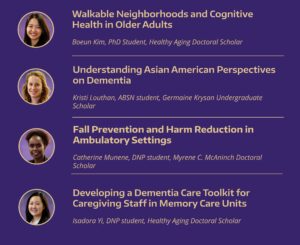
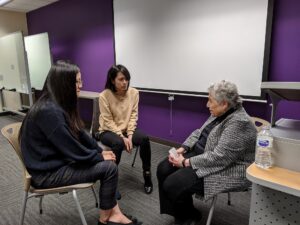
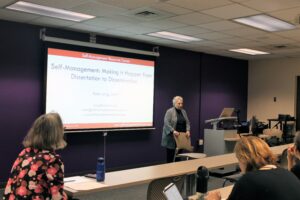 Lorig emphasized the importance of “thinking outside the box, but not too far outside the box” for researchers. Stick with novel research, but work within the system. Make studies that can be replicated and pick outcomes that policymakers care about. Know what major funders and organizations in the field are looking for and collaborate with people who know the field well.
Lorig emphasized the importance of “thinking outside the box, but not too far outside the box” for researchers. Stick with novel research, but work within the system. Make studies that can be replicated and pick outcomes that policymakers care about. Know what major funders and organizations in the field are looking for and collaborate with people who know the field well.